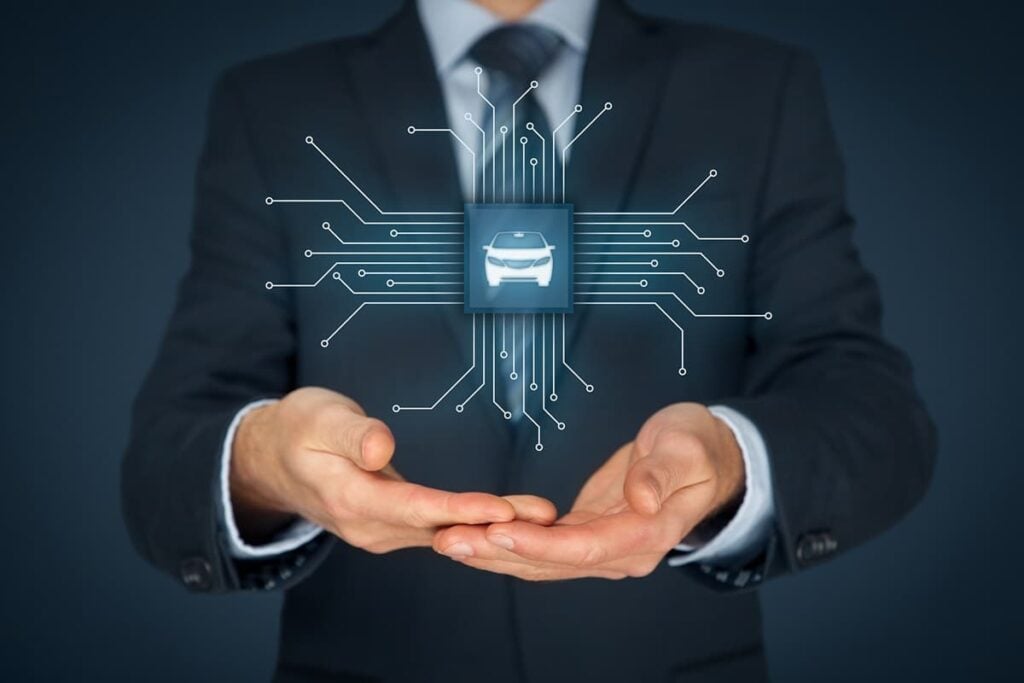What is Telematics? A Simple Definition
Table of contents

Peter Thiel once wryly quipped that we wanted flying cars and instead, we got 140 characters. What’s even worse than that is the complete drivel that floats across that 140-character platform. Just look at these two gems that are trending on Twitter right now as we type this:
- Kanye reignites his beef with Drake and (possibly) squashes it within an hour
- Ariana Grande nails the whistle tones in her new song
It’s a miracle that some of these people can even tie their shoes in the morning. Still, there may be hope for society as technologies continue to be developed that result in improving our lives as opposed to making stupid people even stupider. One of those technologies is telematics.
What is Telematics?
The Internet-of-Things (IoT) is all about connecting everything to “the cloud” so that we can generate loads of big data and make better decisions. There are more than 1.2 billion motor vehicles registered across the globe, all of which can become connected to servers that can then start churning out useful insights. The bi-directional transfer of data between vehicles and “the cloud” – usually by means of mobile communications – falls under a category of technology we refer to as “telematics,” and it can take a variety of different forms and shapes such as:
- Tracking shipments across various transport methods
- Pay-as-you-go auto insurance plans
- In-car driver assistance
- Any number of applications for on-demand vehicle usage and “the sharing economy”
In the simplest form, information from the vehicle is recorded via a small, telematics device — also called a black box — that plugs into the vehicle’s communication port. A SIM card and modem in the device then enable communication on a cellular network. Using these communications-enabled devices, we can then store, send, and receive information. With the advent of 5G, expect this area to explode with activity. Let’s take a look at a few examples of some startups around the globe that are working on applications for telematics technology.
Telematics for Anything Shipping


They also apply their own predictive analytics to estimate information like arrival and pickup times. Using configurable push notifications, emails, or SMS, project44 lets anyone in the supply chain receive the latest shipment info that’s relevant to their needs.
The Airbnb of Construction
Founded in 2014, Missouri startup EquipmentShare has taken in $58.7 million in funding so far to develop “Track” which is dubbed as “the only telematics solution built specifically for construction and mixed fleets.” Initially, EquipmentShare adopted the sharing economy model famously utilized by Airbnb to host a platform that allowed contractors to buy, rent, and share their equipment. The goal was to solve the costly problem faced by every contractor: to either purchase an expensive machine that will only be used a couple of times for an important project or shell out large amounts of cash in rental fees every time they need the machine. When their initial model worked, EquipmentShare eventually saw how much they could grow with telematics.

EquipmentShare Track allows contractors to view and analyze data to help prevent accidents on their work sites by identifying reckless operators and uncertified employees from handling expensive machinery. Features like Geofences and Access Codes also prevent theft or unauthorized use of equipment. In effect, a safer and more secure workplace means lower insurance premiums – a win-win for everyone.
Seguro Para Todos
We’ve talked before about startups like Metromile which offer “pay-as-you-go insurance,” a value proposition that is fairly easy to understand. But our next startup has taken this concept even further, to markets where being insured isn’t even common. Founded in 2014, Chilean startup Jooycar has taken in $3.2 million in funding so far to open up an entirely new market for insurance companies. The company primarily focuses on the South American market – a region that has an inexplicably high number of drivers without insurance. By identifying the root of the problem, the cost-prohibitive nature of premiums, Jooycar has leveraged telematics technology to offer a Usage-Based Insurance platform (UBI). In short, the company helps drivers cut down on costs through a pay-per-mile option.

This kind of flexibility has encouraged car owners to avail of insurance for the first time, which led to the company’s explosive growth in three years’ time. Next up, they plan to expand and tap into the $280 billion auto insurance premium market in the United States – a place where they’ll find no shortage of competitors. Maybe instead, they can consider taking this business model into India so we don’t have to put our lives on the line every time we step onto an Indian bus.
Roadside Assistance Reinvented


The app offers multiple options including towing, fuel delivery, jump start, and ditch retrieval. On top of these features, the app also has an accident detection feature that uses your smartphone as a motion sensor to determine if your vehicle has been involved in any accident.
Telematics for Maritime Insurance
Telematics technology isn’t just used for land-based applications, but on the open sea as well. Founded in 2012, London startup Concirrus has taken in approximately $14 million in funding so far to serve the commercial marine and motor insurance markets. The company interprets large sets of static demographic and dynamic behavior-based data sets, and combines these with historical claims information to reveal the behaviors that correlate to claims. Through integrating with an insurer, reinsurer, or broker’s existing system, it then uses artificial intelligence to reveal previously hidden behaviors that correlate to claims. While there are plenty of startups using artificial intelligence to better predict risk in the insurance industry, Concirrus is unique in that they’re applying these techniques to maritime insurance.

As you can probably guess, insuring ships is a whole different animal and you can’t just apply the same rules as you would for auto insurance. The ability for ships to be connected to their platform allows the company to charge more accurate insurance premiums based on factors like usage, time in port, locations, and the like.
Getting Rid of the DMV
Founded in 2009, Foster City startup Reviver Auto has taken in $24.1 million in funding so far to develop the world’s first digital license plate. Their Rplate Pro product transforms the 125-year old stamped metal license plate into a sleek, digital, high definition display that offers new efficiencies and benefits. The Rplate’s connected car platform will soon automate DMV renewals, replacing legacy stickers with digital decals, and add new levels of personalization to the license plate.

In addition to enabling users to automatically renew DMV registration, the Rplate allows consumers to view their vehicle’s telematics and customize the look of their plate by changing the background (black to white / white to black) and adding DMV-approved cause or personal messaging, such as “Support Our Troops,” “God Bless America,” or “I’d Rather Be Running.” As a truly cutting-edge and unique aftermarket product, the Rplate, which beautifully integrates with today’s vehicle styles, offers dealers an additional way to differentiate their dealerships and add value for their customers. The Rplate Pro has been approved for use in California, and launched onto California roads in mid-2018 (under pilot). Reviver Auto is on track to expand to more states in 2019. What a genius idea.
43,833,795 Vehicles and Counting


Airbiquity has been connecting vehicles for 20 years now, and has enabled 43,833,795 vehicles and counting with their telematics technology. Airbiquity’s product offering runs the gamut of things we’ve already discussed and more, including infotainment, service management, and unique offerings for electric vehicles.
Conclusion
As telecoms look to reinvent themselves, they’ll look to vertical integrations to expand into new areas. Telematics applications are a prime target because they rely so heavily on mobile communications infrastructure. Verizon Communications (VZ) recently acquired a telematics startup called Telogis, a startup with which they competed against prior to the acquisition. Verizon Telematics is active in roughly 40 countries, and the move to acquire Telogis was reportedly because the latter had more superior technology and a better client roster. At the time of the acquisition, TechCrunch speculated that the startup was profitable with $150 million in annual revenues. There’s a lot of money to be made in telematics, and that means there are many viable exits for successful telematics startups.
Telematics isn’t just about monitoring the driving habits of teenagers, or offering some stranded elderly people roadside assistance. It’s gone far beyond that, by allowing us to establish bi-directional communication with almost any moving object. The world is becoming more connected every day, and new ways to use location-based information are being developed constantly. All these connected devices are also generating loads of new “big data” sets that we will then feed to hungry AI algorithms in order to further optimize the world. As a wise man named Drake once said, “in order to be successful you’re going to have to do something different than what everyone else is doing.”
Sign up to our newsletter to get more of our great research delivered straight to your inbox!
Nanalyze Weekly includes useful insights written by our team of underpaid MBAs, research on new disruptive technology stocks flying under the radar, and summaries of our recent research. Always 100% free.













